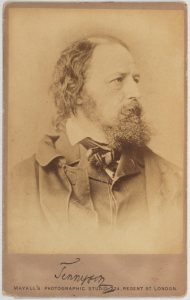Alfred, Lord Tennyson (1809-1892)

Portrait of Alfred, Lord Tennyson by John Jabez Edwin Mayall
Medium: albumen cabinet card. Dimensions: 3in. x 2 1/4in. (89 mm x 58 mm), 1864. © National Portrait Gallery, London. Used with permission.
Tennyson was the grand old man of Victorian poetry, holding the Laureateship for 42 years and famous for In Memoriam A.H.H., The Idylls of The King and Maud, and Other Poems – the last of which includes “The Charge of the Light Brigade.”
He was born at Somersby Rectory, near Lincoln in 1809, the fourth of 12 children, and taught by his father to love poetry from an early age. In 1827, he went to Trinity College, Cambridge, where he found the teaching dull but made strong friendships, notably with Arthur Hallam, who wrote to Gladstone that he was ‘promising fair to be the greatest poet of our generation, perhaps of our century’. In 1829, he won the Chancellor’s Gold Medal for his poem “Timbuctoo.”
He left Cambridge after the death of his father, and published two collections of poems in the early 1830s, which included “The Lady of Shalott,” “Mariana in the South,” and “The Lotos-Eaters.” Undeservedly venomous criticism discouraged him, but he rallied and improved the weaker poems. In October 1833, the sudden death of Hallam plunged him into a period of deep depression and mourning. Over the next 17 years he continually worked on and revised a poetic tribute to his friend, which he published as In Memoriam A.H.H. in 1850. The poem became one of the best known and best loved of the period, with Queen Victoria saying that next to the Bible, it was her greatest comfort following the death of Prince Albert. The month after the publication of In Memoriam, Tennyson married Emily Sellwood, and in November he was appointed Poet Laureate.
Tennyson wrote many of his most famous poems, such as ‘Morte d’Arthur’, ‘Ulysses’ and ‘St Simeon Stylites’ in the period between Hallam’s death and the publication of In Memoriam. In 1847 he published The Princess, a long narrative poem on the subject of women’s education.
The Tennysons moved to the Isle of Wight in 1853. The Crimean War inspired him to write “The Charge of the Light Brigade,” which appeared first in The Examiner in December 1854. In 1859, he published the first four poems in his Arthurian poem cycle Idylls of the King; the twelfth and final poem in the cycle would not be published until 1885. Queen Victoria granted Tennyson a barony in 1883. He died in 1892.
Text is a derivative of “Alfred Lord Tennyson,” The British Library, and is licensed under CC-BY-4.0.=

